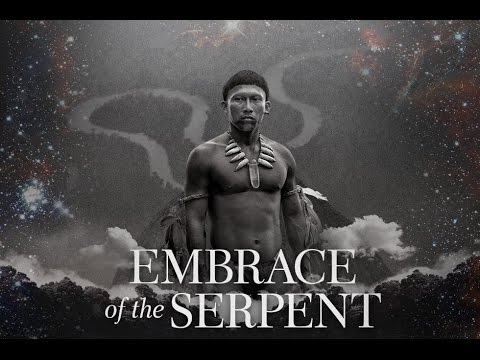Embrace of the Serpent is a poignantly exquisite Colombian film by Ciro Guerra. The story features Karamakate, an Amazonian shaman of the fictional Cohiuano tribe, and his encounters with Theo, an ethnographer, and Evan, an ethnobotanist. We first meet Karamakate in 1909 as a young man standing on the edge of a river witnessing the approach of a canoe carrying Manduca, a westernized Amazonian man, and Theo, who is very ill. Karamakate lives alone in deep jungle, the sole survivor of his tribe, victims of genocide propagated by the rubber barons. He is told by the new arrivals they are desperately seeking the yakruna plant, said to be growing solely in one remote site unknown to them. Only a concoction from the yakruna can cure Theo, clearly on death’s door. Karamakate adamantly declines their request he serve as their guide but finally relents.
He tells Theo, “You are two men. One is a chullachaqui. We all have one. He looks just like us but he’s empty, hollow. It drifts around the world like a ghost, lost in time, without time.”
Fast forward a few decades, we see Karamakate standing listlessly in front of a large stone with pictographs. His spirit is lost. He does not remember the ways of his people or the healing rituals he long performed. Again, a white man in a boat shows up at water’s edge. This time it’s Evan. He wants Karamakate to guide him to a rare plant with sacred properties called the yakruna. Again, Karamakate declines to engage but finally agrees. There is the sense he knows he merged with his chullachaqui and is looking for his own cure.
Evan is very attached to the heavy boxes and all the equipment of his trade, dangerously weighing down the boat. Karamakate finally chides him.
“To become a warrior every Cohiuano man must leave everything behind and go into the jungle, guided only by his dreams. In that journey he has to discover, in solitude and silence, who he really is. He has to become a vagabond of his dreams. Some get lost and never come back. But those who do, are ready to face whatever may come.”
This is a tale of two journeys, a graphic depiction of murderous devastation wrought by the rubber barons, and the evolutionary effects of colonialism and religion, contrasted with the extraordinary nature of the Amazon and resilience of her people.
Theo and Evan are loosely based on Theodor Koch-Grünberg and Richard Evans Schultes, respectively, and journals of their separate Amazonian explorations. The fictional yakruna plant is likely derived from the ayahuasco and chacruna plants, both psychoactive, used to make the brew ayahuasca.
The film was shot in black and white, emphasizing its stark tale. I was deeply impacted by the movie and history it portrays, one that repeats. Watching it, I couldn’t help but also receive a clear message toward what we’re undergoing globally with the pandemic: the tragic suffering of Indigenous peoples, and a warning to retreat to nature and our sensibilities.
Glen Shepard is an anthropologist, filmmaker and curator at the Goeldi Museum in Belém, Brazil. In his article Fifty Shades of Green, he wrote a detailed account pointing to where Guerra used sensationalism and took artistic license relating to Indigenous culture and tradition. But he also recognized the worth of its worldwide screenings, relaying a repetitive record, one made even more real by the news that Antonio Bolivar, who played the elder Karamakate, has succumbed to COVID-19. He was one of the few remaining Ocaina people of the Amazon.
Embrace of the Serpent was an Academy Award nominee for best foreign language film and several other awards between 2015-2017. It’s peppered with several Indigenous and European languages with English subtitles. Watch it online via the film’s website or Amazon Prime, Vimeo, Googleplay and other platforms.
Trailer: https://youtu.be/uymNkBuR-SY











Read 0 comments and reply